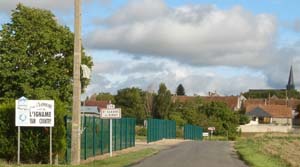
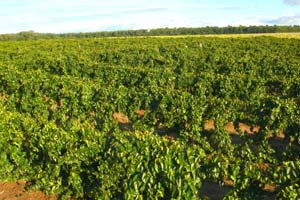
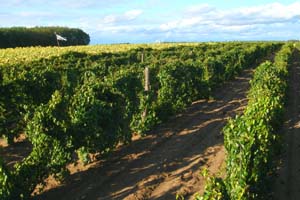
 |
 |
 |
| Une entrée du village de Saint-Claude de Diray (Loir-et-Cher) | Champ d'igname (ancien champ de tabac) | Tuteurage des plants à l'aide de cable en fer ou plastique tirés entre des poteaux en bois espacés de 8 m |
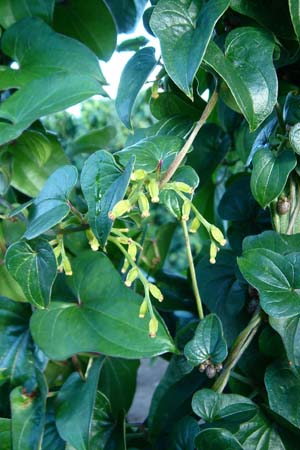 |
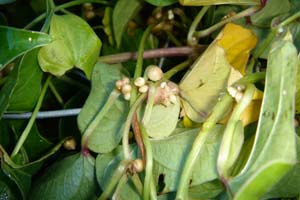 |
Fleurs femelles |
Bulbilles aux noeuds |
Akihisa T, Tanaka N, Yokota T, Tanno N, Tamura T. 1991. 5 alpha-Cholest-8 (14)-en-3 beta-ol and three 24-alkyl-delta-8 (14)- sterols from the bulbils of Dioscorea batatas. Phytochemistry 30:2369-2372.
Aoba T. 1997. Carbohydrate content in tubers of Chinese yam produced under various cultural conditions and at various stages of tuber growth. Yamagata Daigaku Kiyo Kogaku 3:263-271.
Arakane Y, Hoshika H, Kawashima N, Fujiya TC, Sasaki Y, Koga D. 2000. Comparison of chitinase isozymes from yam tuber - enzymatic factor controlling the lytic activity of chitinases. Bioscience, Biotechnology and Biochemistry 64:723-730.
Arakane Y, Koga D. 1999. Purification and characterization of a novel chitinase isozyme from yam tuber. Bioscience, Biotechnology and Biochemistry 63:1895-1901.
Araki H, Harada T, Yakuwa T. 1981. Studies on the botanical characteristics of genus Dioscorea, 3: Effect of sucrose, boric acid and temperature on pollen germination of Chinese yam Dioscorea opposita L. cv. Nagaimo. Journal of the Faculty of Agriculture, Hokkaido University 50:229-235.
Araki H, Harada T, Yakuwa T. 1983. Some characteristics of interspecific hybrids between Dioscorea japonica Thunb. and Dioscorea opposita Thunb. J.Jpn Soc.Hort.Sci. 52:153-158.
Araki H, Harada T, Yakuwa T. 1987. Studies on the botanical characteristics of genus Dioscorea, 5: development of capsul, seed and embryo of Dioscorea opposita cv. nagaimo and possibility of embryo culture. Memoirs of Faculty of Agriculture, Hokkaido University 15:133-139.
Araki H, Shi L, Yakuwa T. 1992. Effects of auxin, cytokinin and nitrogen concentration on morphogenesis of tissue-cultured shoot apex of Chinese yam (Dioscorea opposita Thumb.). Journal of the Japanese Society for Horticultural Science 60:851-857.
Araki T, Koga D, Ide A, Torikata T. 1989. Study of the primary structure of yam (Dioscorea opposita Thunb.) tuber chitinase, 1: Amino acid sequence of the tryptic peptides. In: Proceedings of Faculty of Agriculture. Kyushu, Japan: Kyushu Tokai University. p 29-35.
Asahira T, Yazawa S. 1979. Bulbil formation of Dioscorea opposita cultured in vitro Memoirs College of Agricult., Kyoto University.Crop Science Series 113:39-51.
Asano Y. 2004. Classification of edible, indigenous Dioscorea species in Japan by leaf morphology and cross-compatibility. Journal of the Japanese society for horticultural science 73:364-373.
Asano Y, Imagawa M. 1999. Hybrid seed formation among Dioscorea opposita thunb. cvs. Nagaimo, Ichoimo,Tsukuneimo, and Dioscorea japonica thunb. Journal of the Japanese Society for Horticultural Science 68:591-597.
Chang WD, Huang WW, Chen CC, Chang YS, Yeh FT, Na C, Hsieh MT, Tsay HS. 1994. The production of secondary metabolites from Chinese medicinal herbs by suspension and tissue culture. Taichung District Agricultural Improvement Station 35:535-540.
Chung HY. 1994. Fractionation and quantitative analysis of lipid components in Korean yam (Dioscorea) tubers. Agricultural Chemistry and Biotechnology 37:509-515.
El-Olemy MM, Reisch J. 1979. Isolation of batatasin 1 from non-dormant bulbis of Dioscorea opposita: an improved method for isolation of batatasin 1. Planta Medica 37:67-69.
Feng X, Shao Q, Jiang X. 1986. Transformation of the monocot Dioscorea opposita using Agrobacterium tumefaciens. Genetic Manipulation Crops Newsl. 2:52-59.
Ferguson TU, Haynes PH. 1970. The Chinese yam as a commercial proposition. Farmer 75:372-375.
Fukumoto F, Tochihara H. 1978. Chinese yam necrotic mosaic virus. Annals of the Phytopathological Society of Japan 44:1-5.
Grange A, Borcard B, Hilbrand E, Magnin P, Gene GJ, Miège J. 1981. Etude de l'eau libre de tubercules de Dioscorea opposita par relaxation magnétique nucléaire. In: L'Igname. Séminaire international, Pointe-à-Pitre, Guadeloupe (France), 28 juillet - 2 août 1980. Paris, France: INRA. Pp 227-232.
Harada Y, Tominaga T, Kemuriyama A. 1982. Pythium rot; a new disease of Chinese yam tubers in cold storage. Bulletin of the Faculty of Agric., Hirosaki Univ. 37:66-80.
Hironaka K, Hirose Y, Okamura T, Ishibashi K. 1984. Field storage of vegetables in cold district (III). Preservation of quality of Chinese yam (Dioscorea opposita Thunb.). Field Crops Research 19:81-89.
Hironaka K, Ishibashi K. 1991. Studies on the storage of chinese yam cv. "Nagaimo" (part. 1) - effect of temperature and packaging method on the quality of Chinese yam. Journal of the Japanese Society of Agricultural Machinery 53:75-83.
Hironaka K, Ishibashi K. 1991. Studies on the storage of chinese yam cv. "Nagaimo" (part. 2) - Changes in quality of Chinese yam stored in a commercial warehouse. Journal of the Japanese Society of Agricultural Machinery 53:31-39.
Hironaka K, Sawaeda K, Ishibashi K. 1992. Changes in viscoelasticity of Chinese yam (Dioscorea opposita) during growth. Journal of the Society of Agricultural Structures 55:13-18.
Hironaka K, Shindou T, Ishibashi K. 1989. Viscoélasticité de l'igname de Chine (Dioscorea opposita Thunb. cv. Nagaimo). Journal of the Japanese Society for food science and technology:891-897.
Honda K, Matsuzawa Y, Koibuchi N, Shimonagane K. 1978. Researches on establishment of labour-saving and high-yielding technical system in Chinese yam (Dioscorea opposita) production. Bulletin of the Ibaraka Agricultural Experiment Station, (Japan) 19:55-108.
Hou WC, Chen HJ, al. E. 1999. Purification and properties of fatty acid esterases from yam (Dioscorea batatas Decne) tuber. Botanical Bulletin of Academia Sinica 40:305-310.
Hou WC, Chen HJ, Lin YH. 1999. Dioscorin, the major tuber storage protein of yam (Dioscorea batatas Decne) with dehydroascorbate reductase and monodehydroascorbate reductase activities. Plant Science 149:151-156.
Ikeuchi Y, Kobayashi H, Hujimoto H. 1976. Studies on culture of Chinese yam plant. 4. Relation between weight of mother tuberous root and size of new tuberous root. Bulletin of the Hyogo Prefectural Agricultural Experiment Station 24:31-34.
Ino M, Aisawa K. 1978. Effect of chemicals on the black scurf of Chinese yam caused by stubby-root nematodes. Proceedings of the Kanto-Tosan Plant Protection Society 25:131-131.
Ireland CR, Schwabe WW, Coursey DG. 1981. The occurrence of batatasins in the Dioscoreaceae. Phytochemistry 20:1569-1571.
Izawa G. 1957. Studies on changes of mineral contents of the Chinese yam plants (Dioscorea batatas Decne) and characters of their growth. J.of Sci.Soil and Manure 27:431-434.
Izawa G, Natake M. 1958. Studies on nitrogen metabolism in Chinese yam plant (Dioscorea batatas Decne). 1. Changes in the content of nitrogenous constituents during the germination period. Sci.Rep.Hyogo Univ.Agric. 3:79-82.
Izawa G, Natake M. 1958. Studies on nitrogen metabolism in Chinese yam plant (Dioscorea batatas Decne). 2. Changes in the content of nitrogenous constituents through the whole developmental stage. Sci.Rep.Hyogo Univ.Agric. 3:83-91.
Kadota M, Niimi Y. 2004. Improvement of micropropagation of Japanese yam using liquid and gelled medium culture. Scientia horticulturae 102:461-466.
Kanazawa T, Terui K, Oikawa R, Horaguchi T, Kikuchi K, Sato K. 2002. Seed germination and subsequent development of male and female Chinese yam (Dioscorea opposita Thunb.) collected in China. Journal of the Japanese Society for Horticultural Science 71:87-93.
Kang DK, Kim SK, al. E. 1998. Study on development of "Sanyakju", traditional folk wine made of chinese yam (Dioscorea batatas Decne). RDA Journal of industrial crop science 40:41-45.
Kawakami K, Takayama A. 1965. Studies on the clonal selection of Chinese yam (Dioscorea batatas Decne). 3. Breeding history and characteristics of some new varieties. Japanese Journal of Breeding 15(3):58-58.
Kay DE. 1973. Root crops. Tropical Products Institute and Products Digest 13:245.
Kim SK, Lee SC, Lee BH, Jeong HJ, Lee IJ. 2003. Changes of endogenous gibberellins in tubers of Chinese yam (Dioscorea opposita) during storage period. Korean Journal of Crop Science 48:281-285.
Kim SK, Lee SC, Shin DH, Jang SW, Nam JW. 2003. Quantification of endogenous gibberellins in leaves and tubers of Chinese yam, Dioscorea opposita Thunb. cv. Tsukune during tuber enlargement. Plant Growth Regulation 39: 125-130.
Kim SK, Shon TK, Park SY, Lee SC, Kim HY, Sohn EY, Jang SW, Choo YS, Kim KU, Lee IJ. 2005. Endogenous gibberellins in bulbils of Chinese yam during growth and storage. Plant production science 8:181-185.
Kitagawa H. 1974. Needle crystals of calcium oxalate in Chinese yam, yamanoimo. Kaseigaku Zasshi 25:27-31.
Kobayashi N. 1991. Production of virus-free plants and its mass propagation by tissue culture in Chinese yam, Dioscorea opposita Thumb. Bulletin of the Saitama Horticultural Experiment Station 18:81-99.
Kodama T. 1978. On the larvae of Palpiter sexnotatus romin Pfitzer (Lepidoptera: Hepialidae) injuring Konnyaku and Chinese yam. Proceedings of the Association for Plant Protection of Kyushu 24:100-101.
Koga D, Sueshige N, Tahara M, Kato M, Ide A. 1990. Callus induction from yam, Dioscorea opposita Thunb., and the subculture. Agricultural and Biological Chemistry 54(1):245-246.
Kohmura H, Araki H, Imoto M. 1995. Micropropagation of "Yamatoima" Chinese yam (Dioscorea opposita) from immature leaves. Plant Cell, Tissue and Organ Culture 40:271-276.
Kondratenko PT, et al. 1969. Chinese yam crop in the subtropics of the USSR. Science and Culture 35:266-267.
Kudo Y, Toyokawa S, Ichinohe K. 1979. Consideration on seed tuber production of Chinese yam (Dioscorea opposita). Tohoku Agricultural Research 25:151-152.
Kuginuki Y, Nishimura S. 1989. Factors affecting the growth and browning of callus in tissue culture of nagaimo (Dioscorea opposita Thunb.). Bull.Nat.Res.Inst.Vegetables, Ornemental Pl.Tea series A:107-116.
Mathieu V. 1988. L'igname de Chine à Saint-Claude de Diray. Rapport de stage de BTSH, Lycée Agricole de Saint-Germain. St Germain, France: Lycée Agricole de St Germain.
Matsuda A, Shimonagane K, Ozaki K, Saito k. 1976. Occurence of leafspot (Cylindrosporium dioscoreae Miyabe et S. Ito) and anthracnose (Gloeosporium pestis Massee) on Chinese yam (Dioscorea batatas Decue) in Ibaraki Prefecture (Japan). Proceedings of the Kanto-Tosan Plant Protection Society 23:32-32.
Miège J. 1981. Différences protéiniques et enzymatiques entre tubercules mâles et femelles de Dioscorea opposita et Dioscorea trifida In: L'igname. Séminaire International, Pointre-à-Pitre, Guadeloupe (France), 28 juillet - 2août 1980. Paris, France: INRA. Pp 279-280.
Nagai T, Suzuki N, Nagashima T. 2006. Antioxidative activity of water extracts from the yam (Dioscorea opposita Thunb.) tuber mucilage tororo. European journal of lipid science and technology 108:526-531.
Nagasawa A, Finer JJ. 1989. Plant regeneration from embryonic suspension cultures of chinese yam (Dioscorea opposita Thumb.). Plant Science 60:263-271.
Nakanishi H, Negura Y. 1958. Productivity of (a) pieces of tubers of Chinese yam in relation to their position on the tuber from which they were cut, and (b) of whole tubers raised from aerial tubers in relation to their size, for early harvesting. J.Agric.Trop.Bot.Appl.(JATBA) 27:120-124.
Nishi S. 1974. 1973 Evaluation of candidate pesticides. (C-4) Herbicides: vegetable crops. Japan Pesticide Information No. 20, 30-34.:30-34.
Nishizawa T. 1973. Pathogenecity of Trichodorus porosus to Chinese yam. Japanese Journal of Nematology 3:33-37.
Niwata E, Matsunaka K, Fukushi K. 1983. Clonal propagation of chinese yam (Dioscorea opposita) from shoot meristem tips. Tohoku Agricultural Research 33:255-256.
Okagami N, Tanno N. 1991. Dormancy in Dioscorea: comparison of dormant characters in bulbils of a northern species (D. opposita) and a southern species (D. bulbifera var. vera). Journal Plant Physiology 138:559-565.
Okamoto T, Suzuki H, Umezaki T, Nagaya Y, Taniyama T. 2001. Effects of using virus free plants in the Chinese yam (Dioscorea opposita Thunb.) cultivation and practical method to distinguish a Japanese yam mosaic virus plant. Japanese Journal Of Crop Science 70:179-185.
Okamoto T, Umezaki T, Nagaya Y, Taniyama T. 2000. Cultural technique for efficient seed propagation of Chinese yam (Dioscorea opposita Thunb.). Japanese Journal of Crop Science 69:476-480.
Okamoto T, Umezaki T, Nagaya Y, Taniyama T. 2000. Effects of seed rhizophore weight and planting density on the yield of a high yielding variety of Chinese yam (Dioscorea opposita Thunb.). Japanese Journal of Crop Science 69:153-158.
Ozawa M. 1972. On occurence and control of brown rot of Chinese yam tuber caused by Fusarium. Nagano Hort.Exp.Bull. 9:56-90.
Saito M, Kando N, Yamaguchi H, Hashimoto T. 1976. Plant growth regulation activities of batatasins III analogues. Plant and Cell Physiology 17:411-416.
Sato I. 1962. Studies on browning of grated Chinese yam. I. On browning substances and factors affecting their content. J.Jpn Soc.Hort.Sci. 31:134-140.
Sato I, Tanabe K. 1971. Studies on the use of MH (Maleic hydrazide) in the cultivation of Chinese yam (Dioscorea batatas). Bull.Fac.Agric.Tottori Univ. 23:47-52.
Sato T. 1997. Genetic relationship among Dioscorea species and cultivars by rhizophore protein analysis with polyacrylamide gel electrophoresis. Journal of the Japanese Society for Horticultural Science 66:535-541.
Sato T. 1998. Seeds and seedlings of Dioscorea opposita through natural crossing. Tropical Agriculture 75:314-316.
Sawada E, et al. 1958. The effect of subsoil condition upon the form and yield of Chinese yam. Hokkaido.Univ.Fac.Agric.Memo. 3:53-58.
Sawada E, Imakawa S. 1958. Studies on the cultivation of Chinese yam. 4. Experiments on the planting time and pre-sprouting treatment of seed-pieces. J.Hort.Assoc.Japan 28:123-129.
Sawada E, Yakuwa T. 1953. The effect of the height of support on the growth, aerial - tuber setting and yield of Chinese yam. Hokkaido.Univ.Fac.Agric.Memo. 1:207-215.
Sawada E, Yakuwa T, Imakawa S. 1958. Studies on the formation of aerial tubers in chinese yam. II. On the aerial tuber formation in sterile culture of vine segments. J.Hort.Assoc.Japan 27:241-244.
Searl S. 1970. Introducing versatile Chinese yam. Farmer, Kingston, Jam. 75:376-380.
Seki M, Hayashi N, Moriizumi S. 1994. Study on chinese yam harvesting works. 1. Many kinds of harvesting methods. Japanese Journal of Farm Work Research 29:28-37.
Senbongi I, Saruta M. 1978. Effect of Di-Trapex oil on root-knot nematodes of Chinese yam. Proceedings of the Kanto-Tosan Plant Protection Society 25:124-125.
Shi L. 1991. Research on tissue culture and multiplication of Chinese yam (Dioscorea batatas Decne.). J.Inner Mongolia Inst.Agric.Anim.Husbandry 12(2):65-69.
Shionoya H. 1979. Practical technique of Chinese yam cultivation. Agriculture and Horticulture 54:669-675.
Shiozaki Y. 1974. Occurence of abnormal flat shape of Chinese yam in cultivation. Agriculture and Horticulture 49:87-88.
Shiwachi H, Onjo M, Hayashi M. 1999. Comparison of ecological characters of water yam (Dioscorea alata L.), Chinese yam (D. opposita Thunb) and jinen-jo (D. japonica Thunb). Japanese Journal of Tropical Agriculture 43:149-156.
Shiwachi H, Onjo M, Hayashi M. 2000. Photoperiodic response of water yam (Dioscorea alata L.), Chinese yam (D. opposita Thunb) and jinen-jo (D. japonica Thunb). Japanese Journal of Tropical Agriculture:107-114.
Takahashi B, Konishi K. 1994. Chinese yam. In: Horticulture in Japan; 24 th International Horticultural congress, Kyoto, Japan, August 1994. Tokyo, Japan: Asakura Publishing Co. Ltd. p 105-106.
Takahashi M, Shimomura T. 1966. Purification of Chinese yam amylase. Hokkaido Daigaku Nogakubu Hobun Kiyo 6:63-62.
Takayama A. 1955. The inhibition effect of maleic hydrazide on the stored corms of Chinese yam (Dioscorea batatas Decne). Proc.Crop Sci.Soc.Japan 24:133-134.
Takayama A. 1956. Effect of maleic hydrazide for inhibition of sprouting on the tuberous root of Chinese yam, (Dioscorea batatas Decne). Proc.Crop Sci.Soc.Japan 25:49-49.
Takenaka T, Kuwabara M, Yatsunami K. 1995. Viscous properties of Chinese yam (Dioscorea opposita Thumb.). Bulletin of the Faculty of Agriculture Tamagawa University:79-89.
Tanaka A, Yasuda K, Wakamura S. 2001. Sex pheromone of Acrolepiopsis nagaimo Yasuda (Lepidoptera: Acrolepiidae), a predominant leafminer on Chinese yam in Tottori Prefecture: 2. field evaluation and activity of the third component. Applied Entomology and Zoology 36:203-207.
Tanaka S. 1970. On tuber-root rot disease of Chinese yam caused by Rhizoctonia sp. Proceedings of the Association for Plant Protection of Kyushu 16:122-124.
Tanaka S. 1977. Chinese yam (Dioscorea opposita Thunb.) in Japan. Tropical Root and Tuber crops Newsletter 10:4-5.
Tanno N, Nakayama M, Okagami N, Abe MO, Yokota T, Tworkoski TJ. 1994. Dormancy induction by gibberellins and endogenous gibberellins in the genus Dioscorea (yams). In: Proc. Plant Growth Regulator Society of America 21st annual meeting, Portland, 3-6 August 1994. USA: Rhone-Poulenc. p 190-195.
Tanno N, Tanno M, Yokota T, Abe MO, Okagami N. 1995. Promotive and inhibitory effects of uniconazole and prohexadione on the sprouting of bulbils of Chinese yam, Dioscorea opposita Plant Growth Regulation 16:129-134.
Tanno N, Yokota T, Abe MO, Okagami N. 1992. Gibberellins induce the dormancy of bulbils of Dioscorea opposita Thumb. In: Proceedings 19th Annual Meeting of Plant Growth Regulator Society of America. p 187-192.
Tanno N, Yokota T, Abe MO, Okagami N. 1992. Identification of endogenous gibberellins in dormant bulbils of chinese yam, Dioscorea opposita Plant Physiol. 100:1823-1826.
Tanoue H, Sameshima Y, Shimozono H, Ichiki M. 1998. Factors affecting the viscosity of freeze-dried yam. Journal Of The Japanese Society For Food Science And Technology-Nippon Shokuhin Kagaku Kogaku Kaishi 45:238-245.
Tono T. 1968. Food chemical studies on the Chinese yam. 2. Analysis of glycoproteins and free amino acids by using amino acid analyser. Trans Tottori Soc.Agric.Sci. 20:129-135.
Toyama M, Takeuchi Y. 1980. Relationship between the micro-meteorological conditions and the Chinese yam (Dioscorea opposita) cultivation in sandy field. 1. Air temperature in the cultivated field. Sand Dune Research 27:1-6.
Toyama M, Takeuchi Y. 1980. Relationship between the micro-meteorological conditions and the Chinese yam (Dioscorea opposita) cultivation in sandy field. 2. Comparison of soil temperature between the two kinds of irrigation method. Sand Dune Research 27:7-13.
Toyama M, Takeuchi Y. 1980. Relationship between the micro-meteorological conditions and the Chinese yam (Dioscorea opposita) cultivation in sandy field. 3. Comparison of relative humidity between the two kinds of irrigation method. Sand Dune Research 27:14-18.
Tsukamoto T, Koga D, Ide A, Ishibashi T. 1984. Purification and some properties of chitinases from yam, Dioscorea opposita Thumb. Agricultural and Biological Chemistry 48:931-939.
Tsukui M, Nagashima T, Sato H, Kozima TT, Tanimura W. 1999. Characterization of yam (Dioscorea opposita Thunb.) mucilage and polysaccharide with different varieties. Journal of The Japanese Society For Food Science And Technology-Nippon Shokuhin Kagaku Kogaku Kaishi 46:575-580.
Tsukui M, Sato H, Nagashiima T, Watanabe T, Takano K, Kozima TT. 1902. Structure characterization of polypeptides of viscous glycoprotein from yam (Dioscorea opposita THUNB.) mucilage. Journal of The Japanese Society For Food Science And Technology Nippon Shokuhin Kagaku Kogaku Kaishi 48:578-585.
Uchikune S. 1977. Effect of Di-Trapex oil on brown rot of Chinese yam. Proceedings of the Kanto-Tosan. Plant Protection Society 24:47-48.
Vernier P, Berthaud J, Bricas N, Marchand JL. 1998. L'intensification des techniques de culture de l'igname. Acquis et contraintes. In: L'igname, plante séculaire et culture d'avenir. Actes du séminaire international Cirad-Inra-Orstom-Coraf, 3-6 juin 1997, Montpellier, France. Montpellier, France: CIRAD. p 93-101.
Wakamura S, Tanaka A, Yasuda K, Yasuda T. 2001. Sex pheromone of Acrolepiopsis nagaimo Yasuda (Lepidoptera: Acrolepiidae), a predominant leafminer on Chinese yam in Tottori Prefecture: 1. identification and field attraction. Applied Entomology and Zoology 36:71-76.
Wang SJ, Gao WY, Liu HY, Chen HX, Yu JG, Xiao PG. 2006. Studies on the physicochemical, morphological, thermal and crystalline properties of starches separated from different Dioscorea opposita cultivars. Food chemistry 99:38-44.
Wang SJ, Liu HY, Gao WY, Chen HX, Yu JG, Xiao PG. 2006. Characterization of new starches separated from different Chinese yam (Dioscorea opposita Thunb.) cultivars. Food chemistry 99:30-37.
Wang SJ, Yu JL, Gao WY, Liu HY, Xiao PG. 2006. New starches from traditional Chinese medicine (TCM) - Chinese yam (Dioscorea opposita Thunb.) cultivars. Carbohydrate research 341:289-293.
Xinhua F, Quiquan S, Xingcun J. 1986. Transformation of the monocot Dioscorea opposita using Agrobacterium tumefaciens. Genetic Manipulation Crops Newsl. 2:52-59.
Yakuwa T, Harada Y, Kasai N, Araki H. 1981. Studies on the botanical characteristics of genus Dioscorea. 2. On the formation and germination of the seed in Chinese yam (cv. Nagaimo). J.Fac.Agric., Hokkaido University 60:220-226.
Yamamoto W, Yoshitani K, Maeda M. 1955. Studies on the Penicillium and Fusarium rots of Chinese yam and their control. Sci.Rep.Hyogo Univ.Agric. 2:69-79.
Yanagino, Niwata E. 1991. Development of in vitro techniques for testing and selecting specific character using cultured plantlets: breeding by tissue culture in garlic (Allium sativum) and chinese yam (Dioscorea opposita). Journal of Agricultural Sciences 46:431-434.
Yarimizu H, Otobe I. 1976. Studies on the method of seed production of Chinese yam in Oita Prefecture (Japan). Kyushu Agricultural Research 38:72-78.
Yoshida Y, Fujishige N, Yamane K, Ijiro Y, Ogata R. 1996. The relationship between flower induction and seed tuber size in Chinese yam (Dioscorea opposita). J.Jpn Soc.Hort.Sci. 64:853-858.
Yoshida Y, Kanahama K. 1999. Effects of photoperiod and temperature on the development of spikes and new tubers in Chinese yam (Dioscorea opposita Thunb. cv. Ichoimo). Journal of the Japanese Society for Horticultural Science 68:124-129.
Yoshida Y, Seino T, Kanahama K. 1999. Combination effects of temperature and photoperiod on the development of flowering spikes and tubers in Chinese yams (Dioscorea opposita cv. Ichoimo). Journal of the Japanese Society for Horticultural Science 68:603-607.
Yoshida Y, Takahashi H, Kanda H, Kanahama K. 2000. Interactive effects between photoperiod and seed tuber weight on the development of flowering spikes and tubers in Chinese yams (Dioscorea opposita) cv. Ichoimo. Journal of the Japanese Society for Horticultural Science 69:472-476.
Yoshida Y, Takahashi H, Kanda H, Kanahama K. 2001. Interactive effects of photoperiods and plant growth regulators on the development of flowering spikes and tubers in Chinese yams (Dioscorea opposita) cv. Ichoimo. Journal of the Japanese Society for Horticultural Science 70:304-309.
Yoshida Y, Takahashi H, Kanda H, Kanahama K. 2004. Interaction between effects of photoperiod and plant growth regulators on the development of tubers and inflorescences in Japanese yams (Dioscorea japonica). Journal of the Japanese society for horticultural science 73:415-420.
Yoshikawa S, Ishikawa H. 1977. Pesticide residues in Chinese yam. 1. Kelthane and Chlorobenzilate. Bulletin of the Mie Agricultural Technical Center 6:53-55.
Zhao GH, Kan JQ, Li ZX, Chen ZD. 2005. Structural features and immunological activity of a polysaccharide from Dioscorea opposita Thunb roots. Carbohydrate polymers 61:125-131.